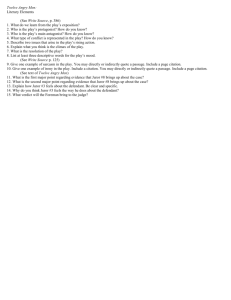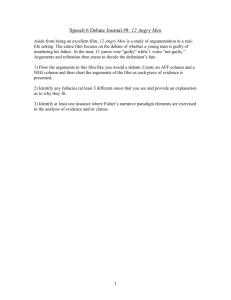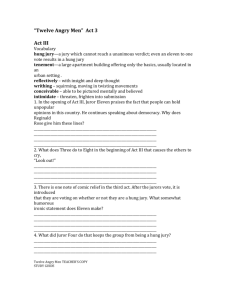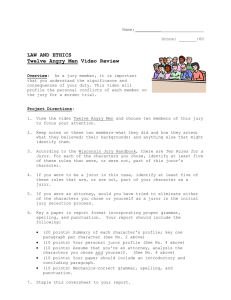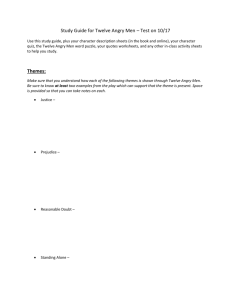12 Angry Men student pkt
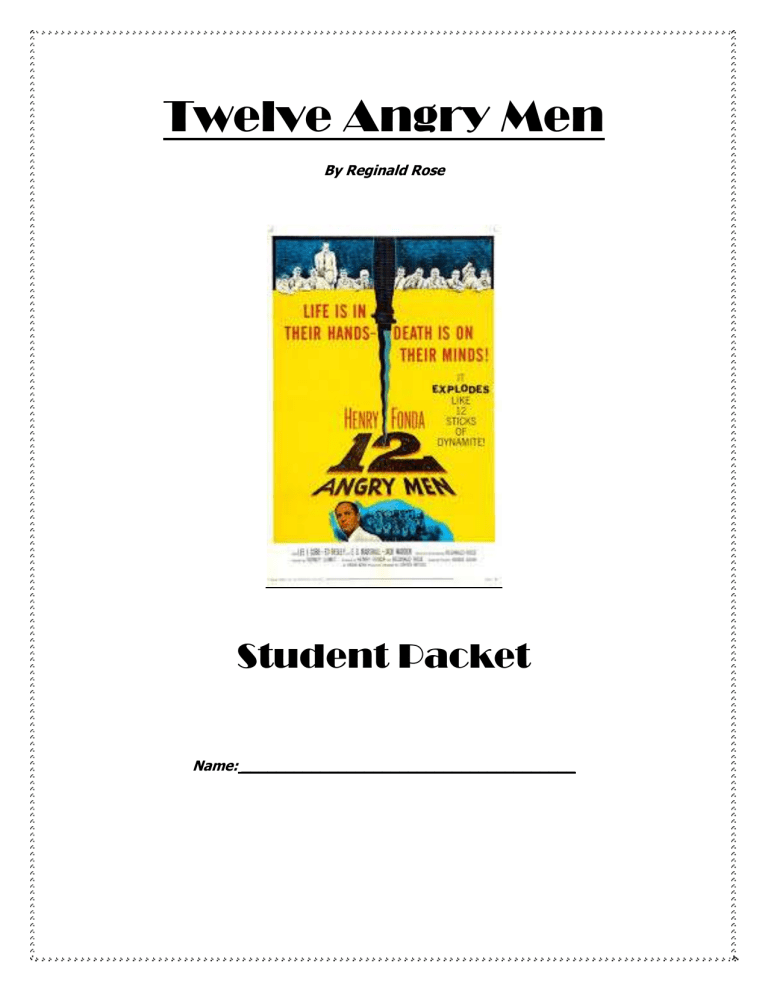
Twelve Angry Men
By Reginald Rose
Student Packet
Name: ______________________________________
12 Angry Men Anticipation Guide
Write “A” for agree or “D” for disagree, based on what you believe. You must choose a side.
1) It is easy to hold an opinion that is not the majority.
2) If someone is found guilty by a court of law, then that person is guilty of that crime.
3) It is important as an American to serve on a jury.
4) If I found myself in a courtroom, I would want a jury of my peers to decide my fate.
5) There are more criminals from poorer areas than from other areas.
6) Everybody is innocent until proven guilty.
7) Juries are fair and impartial.
8) Currently, a jury must reach a unanimous decision on a defendant’s guilt/innocence.
Should this be changed to a majority vote?
9) Everyone has biases towards certain races, ethnicities, gender, etc.
10) The death penalty is a fair penalty for certain crimes.
11) Victims/victim families should have a say in the defendant’s punishment.
About the Author
Reginald ( Tulip, Rose, Daffodil ) was born on December 10, 1920 in New York
City. He ( attended, left, bench ) City College from 1937 to 1938 but did not graduate.
During World War II and shortly after, he ( granted, walked, served ) in the U.S. Army, from 1942 to 1946, ending his army ( career, tent, car ) as a first lieutenant.
In 1943, Rose ( murdered, married, stole ) Barbara Langbart and they had four
( dogs, fish, children ). After the war and continuing into ( a, the, it
) early 1950’s, Rose worked as a clerk, publicity writer for Warner Brothers Pictures, and advertising
( copywriter, boy, guru ). He also wrote short stories and ( novels, vignettes, boxes ) but he never had any ( triumph, luck, tickets ) selling his work until he turned to
( fighting, drawing, writing ) plays for television and sold his first teleplay, Bus to
Nowhere to the live CBS dramatic anthology , Studio One , which aired in 1951.
Three years later, Reginald Rose became the head ( chef, writer, critic ) for that series and created the work that would become his masterpiece. Overwhelmed by the intense drama of the ( jury, electric, flower ) system while serving as a juror on a manslaughter case, Rose successfully translated the heated debate that takes place behind courtroom doors into the Emmy-winning drama Twelve Angry Men . The teleplay was first ( broken, bridge, broadcast ) in September, 1954 and went on to much success in lengthened and revised versions as a stage play, film and made-for-television movie.
Reginald Rose continued to ( act, watch, write ) television scripts into the 1960’s and beyond. Other screenplays, besides Twelve Angry Men ( dealt, included, ransom )
Somebody Killed her Husband , The Wild Geese , and Whose Life is it Anyway? starring
Richard Dreyfus.
Rose’s first marriage ( ended, went, had ) in divorce. He married his second wife,
Ellen McLaughlin in 1963; they had two children. Reginald Rose ( disintegrated, died, left ) in 2002 in Norwalk, Connecticut from complications of heart.
Summarize what you know about Reginald in 5 sentences: (5 paragraphs=5 sentences)
______________________________________________________________________
______________________________________________________________________
______________________________________________________________________
______________________________________________________________________
______________________________________________________________________
______________________________________________________________________
______________________________________________________________________
______________________________________________________________________
______________________________________________________________________
______________________________________________________________________
______________________________________________________________________
Juror #1 is the Foreman of the jury. He is serious about his role and tries to run the proceedings in an orderly fashion, reminding the jurors “Just let’s remember we’ve got a first degree murder charge here. If we vote guilty, we send the accused to the electric chair.”
Juror #2 is timid, quiet and unsure of himself, finding it hard to maintain an independent opinion until he finds the courage to point out an important question about how the murder was actually committed.
Juror #3 is the antagonist. He is a forceful, intolerant bully who sees the case as simple and believes the accused is absolutely guilty. He is quick to lose his temper. His desire to convict and punish the defendant is directly related to his feelings of anger and betrayal in regard to his poor relationship with his own son.
Juror #4 is a stock broker, well-dressed, logical and well-spoken. He urges his fellow jurors to avoid emotional arguments in favor of rational discussion. He also believes strongly in the defendant’s guilt until the one piece of evidence on which he bases his vote is discredited.
Juror #5 is a young man who is nervous about expressing his views, particularly in front of the older members of the jury. When two jurors talk disparagingly of kids from slum backgrounds, he finally speaks up, saying he has lived in a slum all his life. He has witnessed knife fights, an experience that will later help other jurors change their opinions about the guilt of the accused.
Juror #6 is a housepainter, a man who is used to working with his hands rather than analyzing with his brain. He is more of a listener than a talker. He does, however, stand up to the bully, Juror #3 when he speaks rudely to Juror #9, an old man, threatening to hit Juror #3 if he ever speaks to the old man like that again.
Juror #7 is a slick, obnoxious salesman whose only concern is to get the deliberations over quickly so he can get to that evening’s baseball game. He assumes that the defendant is guilty and has no interest in discussing it. At one point he makes some prejudiced remarks about immigrants in reference to Juror
#11.
Juror #8 is a quiet, thoughtful man whose main concern is that justice be done.
An architect by profession, he is the first juror to vote “not guilty” on the very first ballot. As he probes the evidence, he manages to cast reasonable doubt on many aspects of the evidence given during the trial. Although the evidence may suggest guilt, it is possible that there are other explanations for what happened on the night of the murder.
Juror #9 is a mild, gentle old man. He is the first to agree with Juror #8 and change his vote to not guilty, saying that he wants a fuller discussion of the case since he is convinced there is not enough evidence to sentence the accused boy to death for allegedly murdering his father.
Juror # 10 , who runs three garages, is a bitter racist. He is prejudiced against anyone who comes from a slum. He believes strongly that the defendant is guilty because he insists that people from slums are all drunks and liars who fight all the time.
Juror #11 is a watchmaker, an immigrant from Europe. Having witnessed great injustices in his home country, he feels fortunate to be living in a country known for its democracy and he has great respect for the American judicial system. He takes his responsibility as a juror very seriously.
Juror #12 works for an advertising agency. He is arrogant and impatient, anxious for the trial to be over so he can return to his career and social life. He is clever, but sees people as statistics rather than human beings.
Setting the Scene – Twelve Angry Men
President Harry Truman
The Cold War
The Korean War
The death penalty
The House UN-American Activities
(HUAC)
The birth of Rock and Roll
Elvis Presley
American Bandstand
Hula Hoops
New York City - summer of 1954
All of these were happening around the time when our story takes place. In order to better understand the time period you are responsible for reporting on your topic for the class.
1) Research your topic to find out what it’s all about.
2) Create a power point presentation to share with the rest of the class. (3 – 5 slides) a.
Summarize the main ideas of the topic – Explain what it is! b.
Find some images, music, timelines, that illustrate your topic to show us c.
Tell us why your topic was important d.
Specifically look for anything around 1954 (when our book takes place)
3) Be ready to give a 2 – 3 minute presentation so that we understand your topic
4) REMEMBER – this is a ONE class period, 3 – 5 slide project.
Your presentation only needs to be 2 – 5 minutes long.
It is a large, drab, bare room in need or painting with three window in the back wall though which can be seen the New York skyline. Off the jury room is a washroom with a wash-basin (sink), soap, and towel and a lavatory (toilet) beyond. A large, scarred table is center with twelve chairs around it.
A bench stands against the wall and there are several extra chairs and a small table in the room, plus a water cooler, with paper cups and a waste basket and an electric fan over the bench and a clock above the cooler and a row of hooks for coats with a shelf over it.
There are pencils, pads and ashtrays on the table. At night, the room is lit by fluorescent lighting with the switch next to the door.
BACK OF ROOM
Twelve Angry Men - Outline Section #1 – pg. 5 - 24
Character Background
Defendant – ___________ years old, boy from the ___________
He was in court at 10 years old for throwing a ____________ at his teacher
________ years old, he was in reform school
He stole a __________
He was arrested for _______________
He was arrested ____________ for slashing another teenager with a ____________
His father has been physically ______________ to him his whole life
Vote
#1 – ______ guilty, _______ not-guilty (Juror #______ not guilty)
Evidence
Prosecution
Witness #1 – Old man that lives ____________: at 10 minutes after 12 midnight he heard loud noises in the apartment above his, he heard the kid yell “___________________________”, he heard a ________ fall, he saw the kid running down the stairs and out of his house.
Witness #2 – Woman in apartment building across the street: she says she saw the kid stick his father with a knife @ 12:10. She’s known the kid all of her life. El train had ______________ passengers on it and the ____________ were out.
Boy couldn’t remember the name of the ____________ he allegedly saw the night of the murder
____ __________ saw him at the movies
Store keeper says he has only ever sold __________ knife like the murder weapon
Motive – kid’s dad has abused him his whole life. At 8:00 the neighbors allegedly heard fighting and someone being slapped 2 times
Defense
1) Boy admitted to going out of the house at 8:00 the night of the murder after being __________ by father
2) The boy went directly to the pawn shop where he bought a _____________ as a present for a friend, he had broken his by dropping it _________ weeks earlier
3) ___________ is very unusual
4) Storekeeper identified knife in ______________ and said it was one-of-a-kind
5) At 8:45 the boy ran into ____________ friends in front of the diner, talked for an hour, showed the knife
6) All boys identified the _______________ in court
7) The boy arrived home about 10:00 – then stories of _____________ and _______________ differ o Boy says he stayed __________ until 11:30, went to all night ___________, came home at 3:15 and found Dad dead o Boy stayed home, had another __________ with his dad, _________ him to death and fled
TWIST ***Juror #8 is able to get a __________ exactly like the ___________ weapon the shop keeper said was ______-____-___-________.
Based on this evidence, how would you vote and WHY?
_____________________________________________________________________________________
_____________________________________________________________________________________
_____________________________________________________________________________________
_____________________________________________________________________________________
_____________________________________________________________________________________
_____________________________________________________________________________________
_____________________________________________________________________________________
_____________________________________________________________________________________
_____________________________________________________________________________________
_____________________________________________________________________________________
_____________________________________________________________________________________
Twelve Angry Men - Outline Section #2 – pg. 25 - 37
Character Background
Victim – “The father wasn’t exactly a ‘___________ ___________’.” – Juror #8
He was in ____________ once.
He was known to be a compulsive (addict, can’t help himself) _______________.
He spent a lot of time in the neighborhood __________ and get into _______________ after a couple of drinks. (Usually over ____________________).
He was a “_____________, cruel, ___________________ (think caveman) kind of man.”
He never held a ____________ for more than six months in his life.
Who would want to murder him…________________ (gambling), _________________,
__________________ or ___________________________________.
Vote
#2 (secret ballot) – ______ guilty, _______ not-guilty (Juror #’s _________________not guilty)
#3 - ______guilty, _______not-guilty (Juror #’s _________________not guilty)
More on the evidence….
Witness #1 – Old man that lives downstairs:
Says he “heard” the kid yell “I’m going to kill you”.
Didn’t hear through the ceiling, heard through open windows (hot night).
He identified boys voice in court blindfolded, picked it out of 5 voices.
What is it that Juror #8 pointed out to try to disprove this?
______________________________________________________________________________
What does Juror #9 say about the old man witness o ______________________________ o ______________________________ o ______________________________ o ____________________, _____________________, ____________________ old man o Never had any _________________________________ o So…. ___________________________________________________________________
Based on this evidence, how would you vote and WHY?
_____________________________________________________________________________________
_____________________________________________________________________________________
_____________________________________________________________________________________
_____________________________________________________________________________________
_____________________________________________________________________________________
_____________________________________________________________________________________
_____________________________________________________________________________________
_____________________________________________________________________________________
_____________________________________________________________________________________
_____________________________________________________________________________________
_____________________________________________________________________________________
Use the information and format provided to you here to outline the important information in the second half of this book
You should include;
Evidence presented
Important Juror statements/opinions
Vote totals
ANYTHING you think is worth noting AND would help you with final essay
Assessments
There will be a 10 question multiple choice and 9 question short answer test along with these essays to ensure that you have understood and thought about this book. Please preview the essays and choose one to be your focus while you read the book. Feel free to take notes while we read that could help you write your essay.
Final essays – Twelve Angry Men
A) This play teaches about group behavior and the role of individual influence in group settings.
What does the play have to say about group behavior and the influence that individuals can have in group settings?
B) One of the themes in "Twelve Angry Men" is the impact of prejudice and preconceived notions on the deliberations by the jury .
Discuss in detail the instances in which prejudice and preconceived notions are revealed in the play and comment on how they can also be problems in real-life group situations.
C) At the end of the play, the reader does not find out whether the defendant is guilty or innocent.
Discuss with reasons whether this is a strength or weakness in the story line.
D) What are the advantages and disadvantages of including "Twelve angry Men" in the literature syllabus for high school students ?
Discuss lessons that can be learned from the text that are/are not applicable to teenage life.
